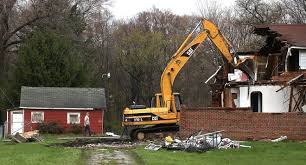
What does all this mean?
You see an ad for a “fixer-upper” but you’re not handy and you really don’t want something hodge-podge in the end for a million dollars anyways.
So, what do all the terms mean? And, what should you do about them?
Let’s start with the process. At the outset, you have farmland in Ontario. It goes through a process to be converted into subdivisions and become part of the urban landscape.
You will appreciate that new subdivisions today cost millions to develop, and developers are not likely to be looking here to determine the steps.
In all likelihood, you are a small contractor and you would like to take on a project of building an entire house, or you are a trade-up homeowner and would like to secure a lot for a custom built house. What are the various steps in the process etc?
First, you will have to secure a lot. As part of the process, you will need an empty lot, that is, one where the existing building has been removed, so that you can build a new structure.
What should you actually be looking for?
There are several issues involving fees and expenses: how large a building can you construct? Is it taxable? What are the development fees? Is there a park dedication required? What are the severance fees? What are the building permit fees? Is it insurable? Is there a demolition fee? Is there a dumping fee?
Do You have a Lot?
You need to have a distinct lot which is capable of being sold or mortgaged before you can do anything. If there is a “double-sized” lot, perhaps 200 feet by 200 feet and you are to acquire the side yard of 100 feet by 200 feet, you really don’t have a lot. This parcel needs to be severed, so as to create, two 100 feet by 200 feet lots.
Depending upon your location, an application must be submitted to either:
- the Committee of Adjustments, or
- the Land Division Committee.
This will depend upon whether the area is located in a one tier or two tier municipality. For example, Toronto is a one tier municipality, whereas Caledon is two tier, namely, the Town of Caledon and the Region of Peel.
You will appreciate that if you must initiate the severance process, this will take some time and money. There are application fees, usually rather modest and consultant’s fees (possibly) before the matter is heard. Notice of your application will be sent to the neighbours, who might indeed attend and oppose your application. The various departments will also be contacted for their input, as well as the school boards notified. Would there be any particular traffic issues? Are you close to an intersection? What does the Town Planner say? Is the Traffic Engineer onside or will you require your own independent report?
It would not be uncommon to require a lawyer ($2,500) and a Planner ($5,000) to attend the hearing.
If you run into problems, you will need some costly consultants to come to your aid. Assuming that you are indeed successful, there is an appeal period which must expire before you can proceed. Your permission will be good for a one year period, otherwise, you need to start afresh.
Once you are ready, you will have to hire a surveyor to prepare an R Plan, or a Reference Plan. This survey will show 2 parcels, A and B. That document will be registered on title. You will use the new plan to describe the lots. A conveyance or mortgage of one property will complete the actual severance. Mere registration of the plan is insufficient.
There are development fees that need to be paid, a park dedication of 5% of the lands or a payment of funds (5% of the value of the property in lieu of dedication). The development fees could easily run in the range of $50,000 to $70,000. On a $500,000 property, the “payment in lieu” of the park dedication would be $25,000.
That’s just to achieve the severance!
Brian Madigan LL.B., Broker
